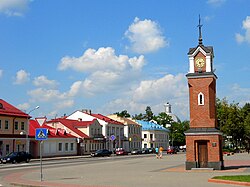Shchuchyn
Town in Grodno Region, Belarus From Wikipedia, the free encyclopedia
Shchuchyn (Belarusian: Шчучын, romanized: Ščučyn,[a] ⓘ; Russian: Щучин, romanized: Shchuchin, IPA: [ˈɕːʉtɕɪn]; Polish: Szczuczyn; Lithuanian: Šukynas; Yiddish: שטשוטשין, romanized: Shtshutshin) is a town in Grodno Region, in western Belarus.[1] It serves as the administrative center of Shchuchyn District.[1] As of 2024, it has a population of 15,371.[1]
This article needs additional citations for verification. (May 2024) |
Shchuchyn
| |
|---|---|
 Svaboda Square in Shchuchyn | |
| Coordinates: 53°37′N 24°44′E | |
| Country | Belarus |
| Region | Grodno Region |
| District | Shchuchyn District |
| Population (2024)[1] | |
• Total | 15,371 |
| Time zone | UTC+3 (MSK) |
| Postal code | 231511, 231513 |
| Area code | +375 1514 |
| License plate | 4 |
| Website | schuchin |
History
Summarize
Perspective
The first known official written mention of Shchuchyn is recorded in 1436, but its foundation as a settlement dates back to 1537, when Shchuchyn was mentioned in the Book of Acts of the Lithuanian Metrica (the Book of Lithuanian vital records), kept in the Governmental archive in Lithuania.
Ownership of Shchuchyn passed from one noble family to another: the Radziwiłł family, the Scipions, the Drucki-Lubeckis,[2] and others ruled Shchuchyn in turn. It was a private town, administratively located in the Lida County in the Vilnius Voivodeship. In the first half of the 17th century, Shchuchyn was governed by the outsider marshal of the Lithuanian principality, Scipio de Campo. Shchuchyn was an average-sized privately owned village in terms of population.
A Catholic Monasterial Order was established 1726 in Shchuchyn by the resolution of the Sejm. A notable Piarist College was founded.[2] In 1742, Teresa Scypionowa founded a monastery of the Congregation of the Sisters of Our Lady of Mercy and a hospital.[2]
Shchuchyn was subject to ruin and ravage more than once in its history. The biggest was in the time of the North War, after the town was seized by the Swedish king Karl XII. After the Third Partition of Poland in 1795, the town became a part of the Russian Empire. In June 1812 Shchuchyn was occupied by French troops. During World War I, in 1915, it was occupied by Germany. In 1919 the Red Army attempted to seize the territory land by taking and fortifying the Martinkantsy - Shchuchyn - Shchara - lake Vygonovskoe line. However, the superior defence forces of the "Land of Grodnenskaya", together with Poland, forced the Red Army back.

Afterwards it was administratively located in the Lida County in the Nowogródek Voivodeship of interwar Poland. According to the 1921 census, the population was 63.1% Jewish, 36.3% Polish and 0.6% Belarusian.[3]
During World War II, the town was first occupied by the Soviet Union, then by Nazi Germany from 25 June 1941 until 13 July 1944, and re-occupied by the Soviet Union afterwards. German forces killed about 2,180 Jews from the Shchuchyn ghetto, with the majority of them killed on 10 May 1942.[4][5]
In 1962, Shchuchyn was granted town status.
Air base
Until the collapse of the Soviet Union Shchuchyn was a home of one of the biggest Soviet air bases with over 5,000 personnel assigned to it in the 1990s. The history of the Soviet air force presence in the city goes back into 1941 with a wing of Polikarpov I-16. The air base hosted different types of the Soviet planes throughout the years, such as IL-28, MiG-15, MiG-19, An-14, MiG-21, MiG-23, MiG-25, and others. Most famously in the early 1990s it was a home of about 40 MiG-25BM defense-suppression aircraft, which represents the vast majority of this modification of MiG-25 ever produced. The base was controlled by the 95th air wing. The base's runway is 2,500 meters long.
Industry
The economy of Shchuchyn is primarily based on industries such as agriculture, food processing, and timber production. The surrounding region is known for its fertile lands, which support agricultural activities. Major businesses are JSC “Shchuchyn plant “Avtoprovod” (found in 1958), JSC "Shchuchyn butter-cheese factory" and a bread factory.
Education
Primary and secondary education: three primary schools (grades one through twelve), a vocational technical school (VTS), a gymnasium. Also there are six government run daycare centres.
Demographics

According to the 2009 census, the population was 44.0% Belarusian, 39,0% Polish, 13.1% Russian and 2.7% Ukrainian.[11]
Notable people
- Onufry Pietraszkiewicz (1793–1863), poet
- Fania Bergstein (1908–1950), poet
Climate
The Köppen Climate Classification subtype for this climate is "Dfb" (Warm Summer Continental Climate).[12]
Notes
References
External links
Wikiwand - on
Seamless Wikipedia browsing. On steroids.



